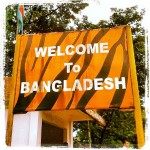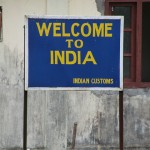

May 13, 2015: Prime Minister Narendra Modi’s success in winning unanimous parliamentary approval for a constitutional amendment designed to eliminate the vexing anomalies along India’s land boundary with Bangladesh is the latest example of his determination to improve New Delhi’s relations with its smaller South Asian neighbors. The amendment still needs to be ratified by the required one half of the Indian states, and that process may not be complete by the time Modi makes his first visit to Bangladesh as prime minister next month. But the broad support it received in both houses of Parliament and the praise Prime Minister Sheikh Hasina, her bitter rival Khaleda Zia, and the Bangladeshi public have given to Modi for his role in pushing it through will significantly help to make that visit another of the successful, high-visibility events that have been the hallmark of his foreign travels.
The anomalies along the land boundary between India and Bangladesh date to the 1947 partition of the subcontinent, when tiny bits of territory were cut off from their national “mainlands” on either side of the newly drawn border. The problem stemmed from the complicated patterns of landholding under the Raj and had apparently not been foreseen by those who had hastily prepared the terms of the partition agreement. The Indian enclaves now surrounded by Bangladesh had been part of the princely state of Cooch Behar, whose Hindu ruler acceded to India. Those that are Bangladeshi were in that part of British India that was awarded to Pakistan in the partition settlement. One rather romantic version has it that some of the small enclaves were payments for gambling debts the Cooch Behar maharajah had incurred.
The boundary was altogether irrational – some of the enclaves are surrounded by enclaves embedded in yet other enclaves. Their inhabitants, almost all poor rural dwellers, had no access to government services and found it difficult to visit the mainlands of the country of which they were citizens. Antagonism between India and Pakistan lessened any interest on either side in reaching an amicable agreement on exchanging the enclaves, an attitude that remained in place until Bangladesh won its independence in 1971. Three years later, Indian Prime Minister Indira Gandhi and her Bangladeshi counterpart Sheikh Mujibur Rahman agreed to swap the areas each side held.
Not that much territory is actually involved: 111 Indian enclaves surrounded by Bangladeshi territory comprising some 17,000 acres were to be transferred to Bangladesh; fifty-one Bangladesh holdings totaling about 7,000 acres embedded in Indian territory would go to India. The total population involved was a little over 50,000, a miniscule proportion of the combined population of the two countries. Those living in the transferred enclaves would be allowed to remain there as citizens of the state that received the territory. It was expected that most would.
The Bangladesh government promptly ratified the treaty: Dhaka has generally been more enthusiastic about settling the issue than New Delhi and it raises far fewer hackles in Bangladesh than it does in India. The main arguments in India against what seemed to be an amicable and mutually advantageous bilateral settlement have been that it is getting shortchanged (it loses a net 10,000 acres) and that the transfer of this Indian territory to Bangladesh will encourage secessionist elements elsewhere in the country. These contentions, which may seem strained to outside observers, have some resonance among people who revere the “sacred soil” of their Indian homeland. In any event, Mrs. Gandhi’s government had not yet secured passage of the constitutional amendment required for such transfers before the assassination of Mujib in 1975 changed the political equation and led India to drop the idea.
The possibility of an enclave swap remained dormant until Indian Prime Minister Manmohan Singh raised the issue when he visited Dhaka in 2011. By that time an India-friendly Awami League government was again in pow
er in Bangladesh, this one led by Sheikh Hasina, Mujib’s daughter. Hasina and Manmohan Singh signed a protocol simply reactivating the main provisions of the earlier draft treaty. The Bangladesh parliament quickly ratified it. However, strong parliamentary opposition in India led by the BJP and eastern India-based regional parties stymied this initiative, and the draft still remained unratified when Congress was defeated in the May 2014 election.
Prime Minister Modi’s decision to obtain the needed parliamentary support for the swap is a good illustration of how some of the positions Indian opposition parties take “in order to oppose” can be reversed when they come to power. But facing a crowded agenda, Modi did not hurry to submit the required constitutional amendment to parliament. And in a move that demonstrated the influence of local politics on foreign policy, he seemed ready to accept the demand of the BJP state branch in Assam to exclude the state from the ambit of the amendment. With a state election looming, local BJP politicians did not want to be accused on the campaign trail of “giving away” Indian territory. Angr
y reaction in Dhaka to this move led Modi to change his position and include the whole boundary. He was quoted as having told Sheikh Hasina “trust me.” And the deal was done. – four decades after it was first negotiated.
Foreign Minister Sushma Swaraj used the occasion of the passage of the constitutional amendment to make some telling remarks in parliament about the Modi’s government’s dealings with its small neighbors. Seeking to r
efute familiar allegations that India had a “big brotherly” attitude toward its South Asian neighbors, Swaraj said that the term symbolizes arrogance. “But,” she went on, “there is also the ‘elder brother’ who is caring. Ours is a caring attitude. India will maintain the attitude of the ‘elder brother’ with our neighbors.”
In years past, Swaraj’s comments would have drawn a cynical response in Bangladesh and elsewhere in the region. But as Prime Minister Modi rounds out his first year in office, the Bangladesh land boundary agreement makes the “caring elder brother” model look like a realistic description of the relationship he is trying to develop with India’s small South Asian neighbors.
Howard and Teresita Schaffer

